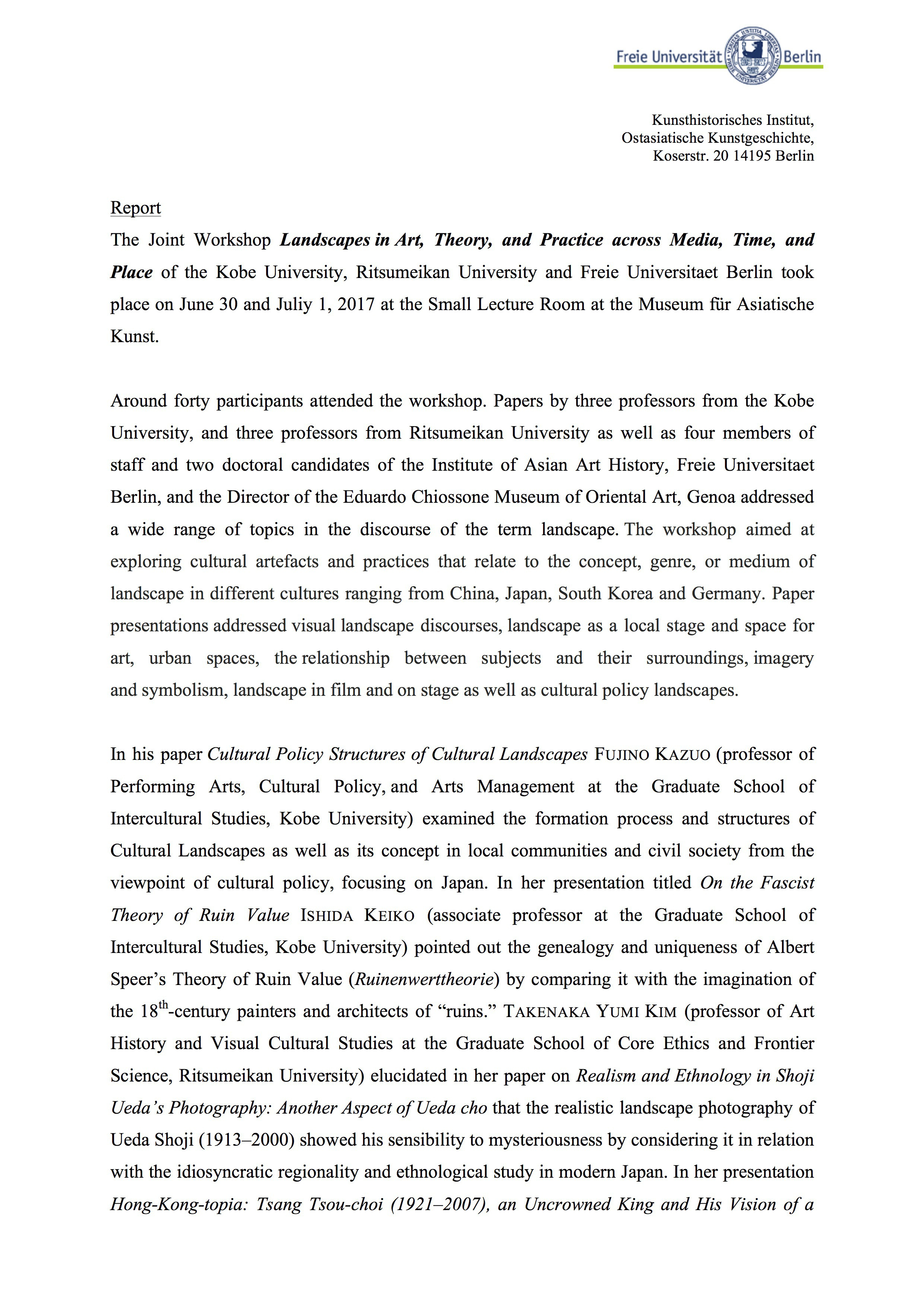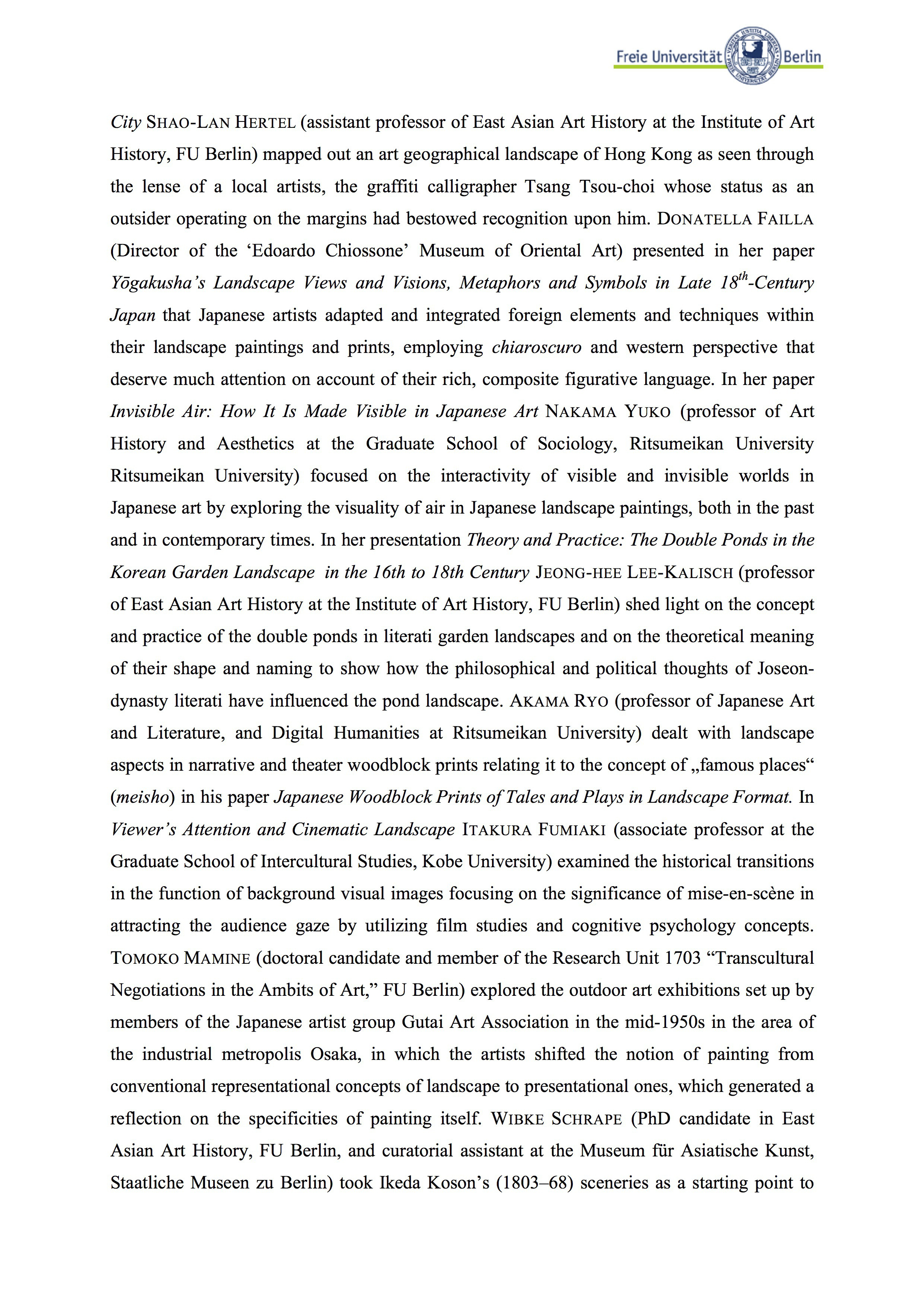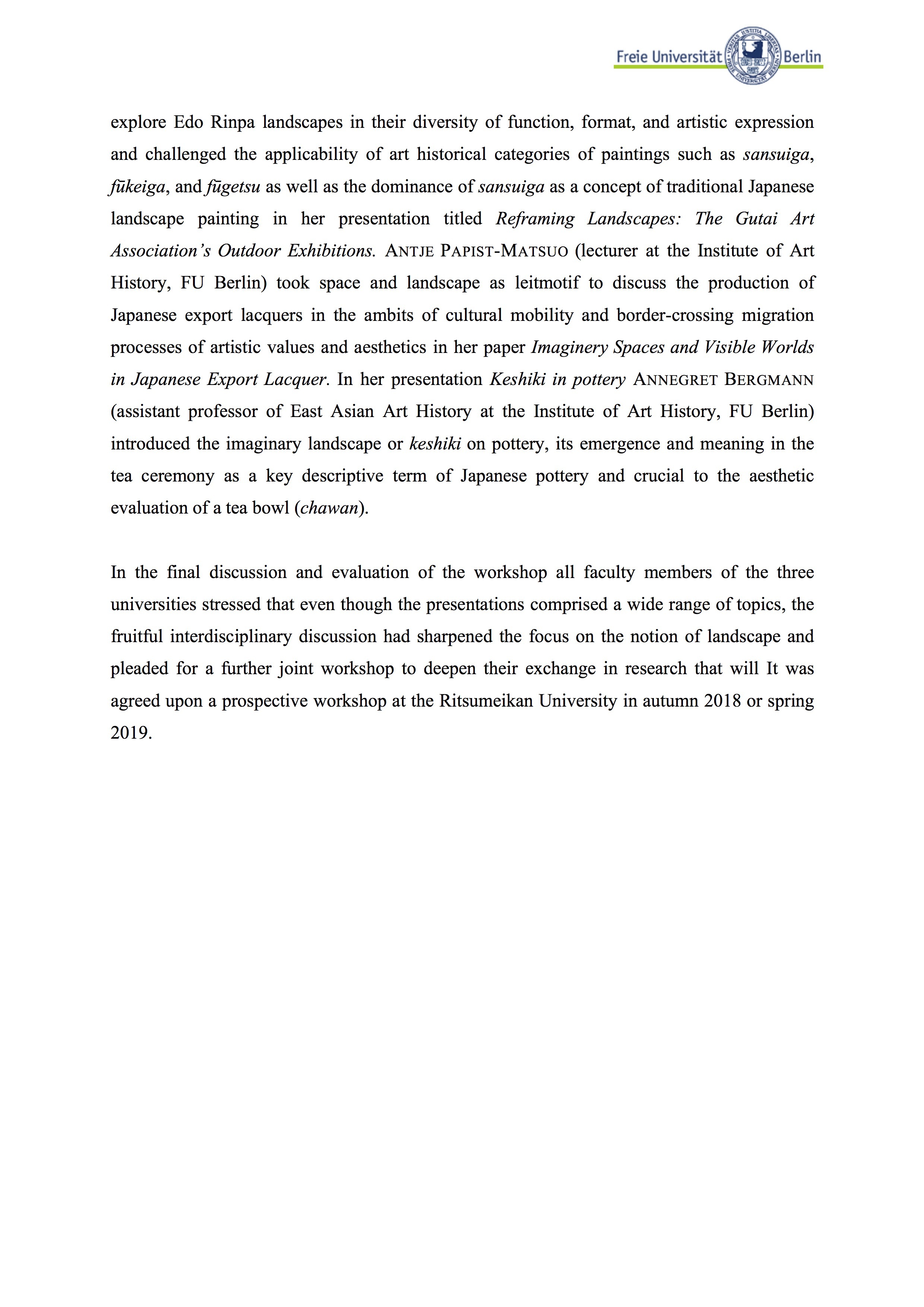Landscapes in Art, Theory, and Practice across Media, Time, and Place
日時:
2017年 6月30日(金)〜 7月1日(土)
場所:
ベルリン国立アジア美術館 小講堂
プログラム:
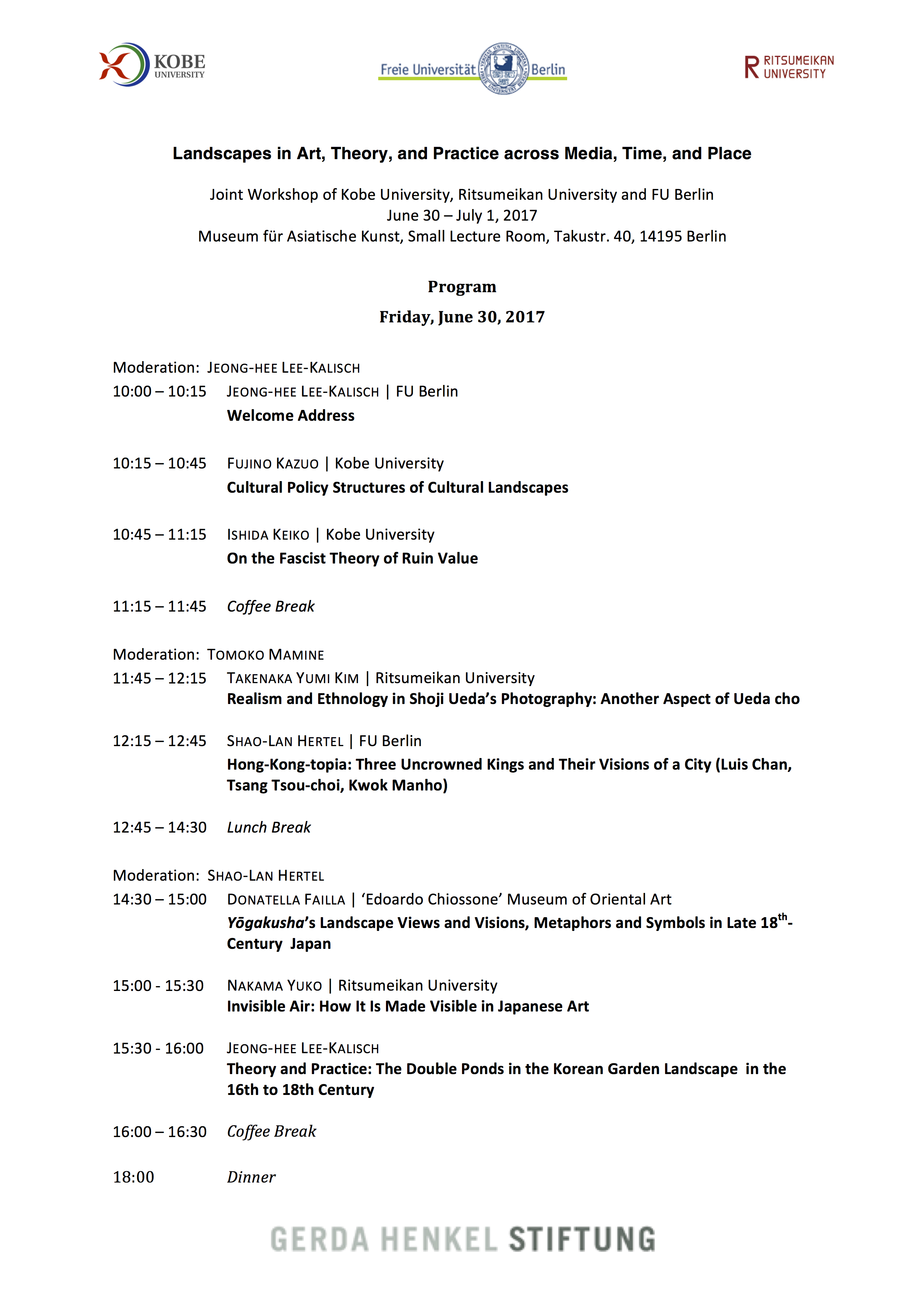
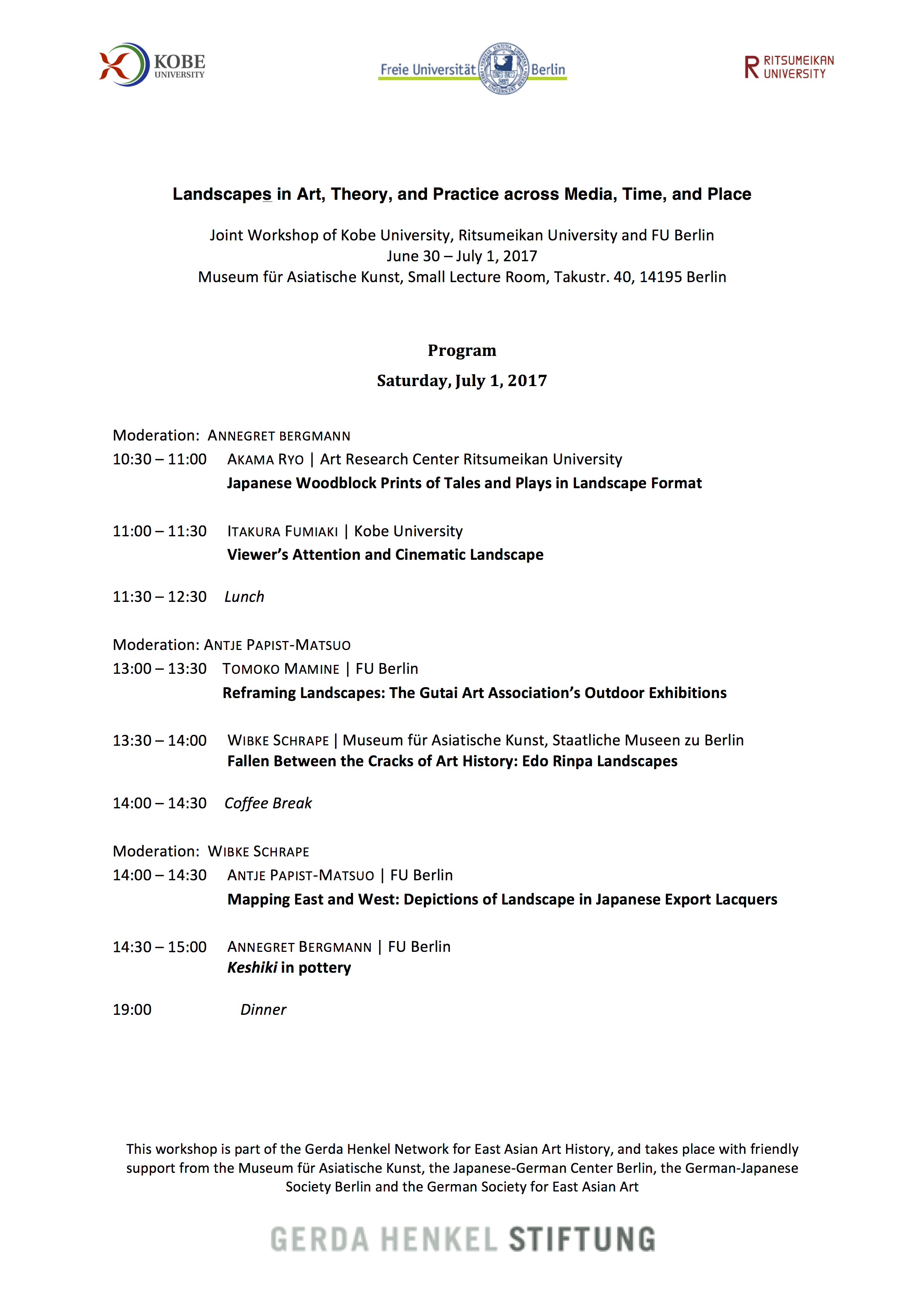
報告要旨:
Cultural Policy Structures of Cultural Landscapes
The concept of Cultural Landscapes was established relatively recently, but it is drawing attention in Japan today. This presentation aims to examine not only the formation process and structures of Cultural Landscapes, but also some topics on this concept in local communities and civil society, from the viewpoint of cultural policy. The movement to protect Cultural Landscapes has been influenced by the UNESCO World Heritage Convention (1972), which finally ratified Japan in 1992. In the same year, this Convention became the first international legal instrument to recognize and protect Cultural Landscapes. The World Heritage Committee acknowledged that Cultural Landscapes represent “the combined works of nature and of man“ designated in Article 1 of Convention; in other words, Cultural Landscapes are classified as “cultural heritage”, not “natural heritage”. On the other hand, after the Great Earthquake Kobe in 1995, the importance of NPOs was widely recognized in Japan, which led to the enactment of the Law to Promote Specified Nonprofit Activities in 1996. In the 21st century, aiming to create more pleasant life in local communities and beautiful scenery in cities and villages, the Landscape Law was enacted in 2004. NPOs or citizens’ action groups are encouraged to be actively involved in carrying out the Law. In the same year, the Law for the Protection of Cultural Properties, which was enacted in 1950, was also revised and as a new category of cultural properties, Cultural Landscape, was introduced, aiming to protect important cultural landscape sites. The Agency for Cultural Affairs has defined Cultural Landscape as follows: “Cultural Landscape formed by the life and work of the people in a given region and the climate of the region are indispensable for understanding the livelihood and work of the Japanese people.“ It is also stipulated that, following a proposal from a prefectural government, the national government can select a particularly important cultural landscape as an Important Cultural Landscape from among those for which necessary protective measures has been taken. As of April 1, 2016, 50 areas across the country have been selected as Important Cultural Landscapes.
FUJINO KAZUO is Professor of Performing Arts, Cultural Policy, and Arts Management at the Graduate School of Intercultural Studies, Kobe University. His area of specialization is the relationship between art and society, mainly in the performing arts of Germany and Japan. He has published numerous books and articles on Richard Wagner. He is a vice-president of the Japan Association for Cultural Policy Research and has been involved in many cultural policy initiatives on a local level. Among his recent publications are Publicity of Public Cultural Institution—Administration,Cooperation, and Philosophy (2011)and "Creation of the Community and Reform of Public Interest Incorporated Association" in The Administrative Reform and the New Initiative of the Cultural Creation (2013).
On the Fascist Theory of Ruin Value
Albert Speer (1905–1981), Hitler's favorite architect, designed some of the Third Reich's most impressive monuments, including the Nazi Party Rally Ground in Nuremberg and the Reich Chancellery in Berlin. His architecture was specifically built according to The Theory of Ruin Value (Ruinenwerttheorie). He argued that the Third Reich monuments should be erected with the consideration that they keep aesthetic value even after thousands of years, such as ruins like Roman and Greek monuments. In his memoirs in 1970, Speer described how he presented his theory to Hitler in the form of a romantic drawing of the future Zeppelin Field as it might look as a ruin— overgrown with ivy. Hitler recognized the value of this theory instantly, and thereafter, Third Reich buildings were to be built with the slogan “stone instead of steel.” A number of aestheticians have suggested that Speer's theory inherited the romantic imagination for ancient ruins by the picturesque, or capriccio, influential aesthetic sentiment in 18th-century Europe. My view, however, is that there is a considerable difference between Speer’s theory and the aesthetic of the 18th century, which found aesthetic value in ruins. In this presentation, I aim to point out the genealogy and uniqueness of Speer's theory by comparing it with the imagination of the 18th-century painters and architects of “ruins.”
ISHIDA KEIKO is an associate professor at the Graduate School of Intercultural Studies at Kobe University. She specializes in aesthetics and art theory, mainly within the relationship of art and politics. She obtained her doctoral degree in 2008 with her dissertation “Mythologization of Reality: The Theory of Fascist Modernism.” Her recent publications include “The Acceptance of George Grosz in Japan During the 1920s and 1930s”. in Intercultural Studies (2015) ,“Tomoyoshi Murayama: From an Avant-Gardist into a Proletarian artist,” in Intercultural Studies (2014), Politicization of Aesthetics: Modernist Poets and Fascism (2013).
Ethnology in Shoji Ueda's Photography: Another Aspect of Ueda cho
TAKENAKA YUMI KIM is Professor of Art History and Visual Cultural Studies at the Graduate School of Core Ethics and Frontier Science, Ritsumeikan University, Kyoto, Japan. She obtained her doctoral degree at Osaka University in 2002. Her dissertation on contemporary art theories in America was published as Bigaku to Gendai-bijutsu no Kyori (2004). Her recent research focuses on photography in the 1930s–1970s. Her latest publications include “FSA photography and the Steichen Collections: The Family of Man and The Bitter Years in Luxembourg”, Aesthetics, no. 20 (2016).
Hong-Kong-topia: Three Uncrowned Kings and Their Visions of a City (Luis Chan, Tsang Tsou- choi, Kwok Manho)
This paper explores and maps out an art geographical landscape of Hong Kong as seen through the lenses of three local artists active from the early twentieth century to the present. The extraordinary modern history of Hong Kong as major trade port, colonized territory, and Special Administrative Region has continually engendered complex forms of artistic production of geopolitical, cross- cultural, and translingual relevance. Whether as exile for yimin loyalists of the Qing dynasty, destination for migrants fleeing the Mainland, or global hub for cultural exchanges⎯the topia of Hong Kong can be defined as both periphery and center, interstice and enclave; further, in Tsong- Zung Chang’s words: “The significance of Hong Kong art from the perspective of twentieth-century China is its identity as the exception.*” While the specificity of Hong Kong art lies in its intrinsically heterotopic condition defying any fixed definition or essentialist narrative, an overarching recurrence within art discourse is a distinct sense of place and time; a consciousness that has shaped Hong Kong identity in the collective imagination of artists over time, not least inspired by the magic of its eclectic topography as romantic harbor, panoramic skyline, and labyrinth of back-alleys, moreover as insular idyll of misty peaks and rural fishing villages. Though working in different languages of painted image, written word, and mixed-media installation, the three artists to be juxtaposed⎯Luis Chan, Tsang Tsou-choi, and Kwok Manho⎯provide significant fragments in assembling a collage of the discourse on landscape and landscape of discourse in Hong Kong art. Albeit presenting self-contained, other-worldly microcosms of sorts, Chan's Fantasy Island Landscapes, Tsang’s graffiti calligraphy, and Kwok's Frogtopia-Hongkornucopia share common ground in their ex-centric scaping of the greater Hong-Kong-topia. Also known as the “King of Watercolor,” the “King of Kowloon,” and “Frog King” respectively, it is precisely these three artists’ uncrowned status as outsiders operating on the margins that has bestowed recognition upon them.
SHAO-LAN HERTEL is assistant professor of East Asian Art History at the Institute of Art History, Freie Universitaet Berlin. She completed her doctoral studies in July 2016 with a dissertation on developments and transformations in calligraphy in twentieth- and twenty-first-century China. Her postdoctoral research focuses on aspects of transculturation in contemporary Chinese ink art. Recent publications include “Lines in Translation: Cross-Cultural Encounters in Modernist Calligraphy, Early 1980s–Early 1990s,” in Yishu: Journal of Contemporary Chinese Art (July/August 2016), and the co-edited festschrift Elegant Gathering in a Scholar’s Garden: Studies in East Asian Art in Honor of Jeong-hee Lee-Kalisch (2015).
* CHANG, Tsong-Zung: “The Full Remainder: Art from Hong Kong.” Hong Kong Eye: Hong Kong Contemporary Art (ed. by Tsong-Zung Chang). Milan: Skira, 2012, 15–19, 19.
Yōgakusha’s Landscape Views and Visions, Metaphors and Symbols in Late 18th-Century Japan
The gigantic change that from 1868 onwards transformed Japan from a feudal country into a modern state was deeply rooted in Rangaku and Yōgaku, the movements in favour of ‘Dutch studies’ and ‘Western studies’, whose earliest inception in Nagasaki dates back to the mid-17th century. Amongst the innovative artistic expressions produced by Rangakusha and Yōgakusha artists, landscape paintings and views, executed employing chiaroscuro and western perspective, deserve much attention on account of their rich, composite figurative language.
Until the mature Meiji period (1868-1912), Japanese artists continued to make exact copies and reproductions of western perspective views and architectural settings, while at the same time they progressively adapted and integrated foreign elements and techniques within their paintings and prints. By so doing, they created a new, eclectic – and at times even cryptographic and disguised – figurative language, one that could covertly express their quest for the general innovation of Japanese culture and art.
DONATELLA FAILLA is the Director of the ‘Edoardo Chiossone’ Museum of Oriental Art in Genoa, Italy, and teaches the History of Art of Eastern Asia at the University of Genoa. After obtaining her PhD in Oriental Studies from the University of Rome ‘La Sapienza’ (1980), she has been employed at the Chiossone Museum of Genoa since 1982, becoming Director in 1995. Failla has organised over 30 exhibitions and authored over 180 publications in Italian, English, French, Japanese and Spanish. She is a member of Accademia Ambrosiana, Classis Asiatica, and has received the ‘Order of the Rising Sun, Gold Rays with Rosette’ for “her activity in the divulgation of Japanese art in Italy, as well as for her contribution to the development of research in the field of Japanese art”.
Invisible Air: How it is Made Visible in Japanese Art
The creation of a sense of air surrounding nature motifs is the essential point of view in Japanese art. This paper deals with the visuality of air in Japanese landscape paintings, both in the past and in contemporary times. Hasegawa Tōhaku (1539–1610) in the Momoyama period and Maruyama kyo (1733–1795) in the Edo-period are no exceptions to this trend. Tōhaku’s Seasonal Willow inspires the viewers to feel that the actual theme of the painting is the invisible wind swaying the leaves. Ōkyo’s ink screen painting of Bamboo in Wind and Rain attempts to visualize the windy and rainy flow of air through the depiction of bamboos. Previous research has pointed out that the painter may have run the ink brush in an improvisational manner in order to catch the movement and change of air. This artistic urge for visible-invisible pictorial space is reflected in contemporary art. Naito Rei (1961* ), an artist who describes herself as a “space” artist, also speaks of the beauty of wind in movement. Hermasterpiece entitled Matrix is the image of spring with moving water drops and pools of water on earth changing their form through the use of technologically created wind. Senju Hiroshi (1958* ) concentrates on his series of waterfalls, the beloved motifs seen traditionally as in A Tour of Waterfall in Various Provinces (Katsushika Hokusai, 1760–1849). Senju's Fall was awarded the Honorable Mention in the 48th Venice Biennale for expressing a “meditative world of nature and the fluctuations of Japan’s traditional culture.” This “fluctuation” of a waterfall by the dynamic splitting of water as a mythological mist of divinity, simultaneously appealing to the viewer's physical senses, is created by the interactivity of visible and invisible worlds that Japanese artists sought for generations. “In perceptual fact they (Senju’s waterfalls) are purely aesthetics” (Donald Kuspit).
NAKAMA YUKO is professor of art history and aesthetics at Ritsumeikan University, Kyoto. Her main research focus is on comparative aesthetics of landscape. Recent publications include The Perception of Nature ― Construction of Landscape. Global Perspectives, Tokyo, 2014 (ed. with Hans Dickel); Caspar David Friedrich und die Romantische Tradition, Berlin, 2011; The Aesthetics of Nature in Japanese Art in the Concept of 'furyu', estetica, studi e ricerche, Bologna, 2016; Period Rooms and the Japanese tradition of appreciating art, THE PERIOD ROOMS, Bologna, 2016; The aesthetics of nature in Japanese art and its historical development, Journal of Zhengzhou University, Zhengzhou, 2015; Aesthetics and Landscape: Crystallization of Nature Images, International Yearbook of Aesthetics, Krakow, 2014.
Theory and Practice: The Double Ponds in the Korean Garden Landscape in the 16th to 18th Century
The two ponds of the “Garden of Vivifying Purification” (Soswaewon) constructed by the young literatus Yang Sanbo (1503–1557) at the foot of the mountain Goamdong in Jeollanam-do province are regarded as the oldest example of the garden landscape style with double ponds of the Joseon dynasty. Based on an analysis of well-preserved hermit gardens of the 16th to 18th century and garden depictions in Korea, this presentation aims to shed light on the concept and practice of the double ponds in literati garden landscapes. The theoretical meaning of their shape and naming as well as the practice of literati are investigated as an example to show how the philosophical and political thoughts of Joseon-dynasty literati have influenced the pond landscape, and in what way the fish, flowers and plants are involved in the concept of the pond landscape.
JEONG-HEE LEE-KALISCH is Professor of East Asian Art History at the Institute of Art History at the Freie Universitaet Berlin. She studied East Asian Art History, Sinology, and Japanology at Cologne University, where she received her doctoral degree in 1991. Her research areas comprise transcultural aspects of East Asian art, especially within the field of literati art and literati garden, Buddhist art, as well as art along the Silk Roads. She published various essays, exhibition catalogues and monographs on these topics and is editor of the publication series Studies of East Asian Art History. Her recent publication includes Ritual and Representation in Buddhist Art and Negotiating Difference, Chinese Contemporary Art in the Global Context.
Japanese Woodblock Prints of Tales and Plays in Landscape Format
In my paper I will deal with landscape aspects in narrative and theater woodblock prints. In Ukiyo-e landscape prints, we find some specific features, for example, the places depicted are always famous. Recent research shows a tendency to call the genre of Ukiyo-e landscape prints meisho-e (prints of famous places). Katsushika Hokusai (1760–1849) and Utagawa Hiroshige (1797–1858) secured the establishment of the genre of landscape prints. Here, especially the Tokaidō Gojūsan tsugi series set trends. However, before their publication, there existed many examples of landscape prints, like Utagawa Toyoharu's (1735–1814) numerous uki-e style prints drawn in perspective, and those of Okumura Masanobu (1886–1764), who started the format around 1745, which inevitably had the horizontal format of a landscape print. Typical uki-e subjects are scenes from inside the kabuki theater, which take advantage of the perspective view most effectively. At the same time, the theater was one of the famous places in the city as well. Thus, there are a lot of landscape prints that depict scenes outside the theater. In his article about a twelve-print-set of the story of the 47 loyal retainers, Chūshingura, Ōkubo Junichi2 points out that the last prints of the series, which always show the scene at the Sengaku-ji temple ground, were produced as landscape prints of Sengaku-ji as one of most famous places in Edo. In the prints, we can see 47 loyal samurai in addition to the view of the coast of Shinagawa and the temple ground. The prints do not only provide a real view and a historical scene, but also a fictional scene in a mixed manner. In the same way, there are a lot of prints that are designed in the landscape print format, which visualize fictional scenes from tales and plays. Edo-period people had no definition of landscape pictures. Real landscape and fiction were mixed at liberty, therefore the landscape aspect in the narrative and actor prints must not be underestimated.
AKAMA RYO is professor of Japanese Art and Literature, and Digital Humanities, at Ritsumeikan University. His main research subjects are Kabuki and Ukiyo-e, and digital archiving of Japanese cultural assets. Recent publications include Imēji dēta bēsu to Nihon bunka kenkyū [Image data bases and the research in Japanese culture] (2010) and Edo no engekisho [Written sources about Edo theater] (2003).
* Ōkubo Junichi: „Chushingura no nishikie to Sengakuji.“ Kokuritsu Rekishi Minzoku Hakubutsukan Kenkyū Hōkoku, 3, 2006, 47–68.
Viewer's Attention and Cinematic Landscape
Utilizing film studies and cognitive psychology concepts, this study examines the historical transitions in the function of background visual images focusing on the significance of mise-en-scène in attracting audience gaze. Since the 1910s, to narrate stories more smoothly and economically, many techniques have been developed like point-of-view shots and shot-reverse shots. These shooting and editing techniques could be considered as a visual reproduction of human perceptions and cognition by film directors. One of the most important fundamentals for film directors is focusing audience attention. Historically, they have positioned the main character or the most important subject in the center of the frame; therefore, audiences have come to intuitively expect the most important subject in the center of the frame. Consequently, little active attention is paid to the background images, as these often possess little narrative information. However, in Japanese film history, there have been a fewexceptions where directors intentionally put important visual information in the background scenes or landscapes. This presentation focuses on silent Japanese films and the works of noted film director Yasujirō Ōzu (1903–1963), to explore the utilization of background and landscape images as narrative components.
ITAKURA FUMIAKI has been an associate professor at the Graduate School of Intercultural Studies, Kobe University since October 2012. He specializes in film studies and the history of Japanese cinema. He received a PhD in Human & Environmental Studies from Kyoto University in 2006. He worked as curator of the National Film Center at the National Museum of Modern Art, Tokyo from 2005 to 2012. His most recent publication was Eiga to Imin (2016).
Reframing Landscapes: The Gutai Art Association's Outdoor Exhibitions
In my paper, I will revisit the outdoor art exhibitions set up by members of the Japanese artist group Gutai Art Association in the mid-1950s in the area of the industrial metropolis Osaka. The challenge of realizing an outdoor art exhibition in the pine grove park in Ashiya City engendered new experimental artistic approaches that ambiguously dealt with the topic of landscape in the context of the so-called “postwar.” On the one hand, the artists grappled with concepts of landscape as established in both Western and Eastern traditions of painting, but also to other scopic visual practices. They shifted the notion of painting from conventional representational concepts of landscape to presentational ones, which generated a reflection on the specificities of painting itself. On the other hand, the artists also responded to infrastructural, industrial and economic developments and urbanization in the Hanshin region, which were particularly fueled by Japan’s reconstruction efforts and the impacts of US-American politics in the aftermath of World War II. Thus, the relation between more narrow art historical notions of landscape and what Tim Ingold claimed to be the original meaning of landscape as the “scaped,” i.e. shaped, land, becomes pertinent. In order to understand these, I will also take into consideration how works by Gutai members related to other cultural and artistic practices that engage with landscape and nature such as architecture, design as well as ikebana.
TOMOKO MAMINE is a doctoral candidate at the Department of Art History of Freie Universität Berlin. She studied art history and history in Berlin and Paris and received her master’s degree from the Freie Universität Berlin in 2010. From 2008 to 2009 she worked as the curatorial assistant of the exhibition “BEUYS. Die Revolution sind wir” at the Nationalgalerie im Hamburger Bahnhof (Staatliche Museen zu Berlin). Since 2011 she has been a member of the Research Unit 1703 “Transcultural Negotiations in the Ambits of Art” at Freie Universität, funded by the German Research Foundation (DFG). In her dissertation she examines the activities of the Japanese artist group Gutai Art Association in the 1950s. Most recently, she has contributed articles to publications of the Internationales Forschungszentrum Kulturwissenschaften (IFK) in Vienna and of the DFG Research Unit 1703.
Fallen Between the Cracks of Art History: Edo Rinpa Landscapes
WIBKE SCHRAPE is a PhD candidate in East Asian Art History at Freie Universitaet Berlin, where she also functioned as assistant professor (2008–12). She currently works as curatorial assistant at the Museum für Asiatische Kunst, SMB. Her PhD project on Ikeda Koson (1803–68) and the Order of Images explores artistic and art historical knowledge production in the formation of the Rinpa genealogy. Her publications include „ Performanztheoretische Perspektiven auf japanische Kulturen des Bildes“ (Bunron: Literaturwissenschaftliche Japanforschung, 1/2014: 12–50); „Im Herbst der Tradition: Zu einer Ausstellung von Malerei der späten Rinpa“ (Ostasiatische Zeitschrift, Neue Serie, 33, 2017: 29–43).
* Kobayashi Tadashi: „Hana to hito ga fuzai no kaiga“. In: Kobayashi Tadashi (ed.). Fūgetsu – Chōjū (Rinpa Painting vol. III). Tokyo: Shikosha, 1991, 222–246, 360.
Mapping East and West: Depictions of Landscape in Japanese Export Lacquers
Japanese export lacquers are premodern objects made in Japan for foreign markets. Their production started in the course of the 16th century with a Portuguese demand and reached a peak during the late 17th and early 18th century when the globally operating Dutch East India Company most effectively operated a cross-cultural lacquer trade, thereby satisfying the ever-growing hunger of the western elite for luxury and exotics. Landscape sceneries form the main part of the pictorial repertoire found on the precious surfaces of Japanese export lacquers. They offer a hybrid visuality, exhibiting compositional arrangements and motifs which can be traced back to both various domestic conventions of traditional visual narratives of landscapes and western perceptions of an idealized nature of the East. By the late 18th century, apredilection for naturalistic views of landscapes and sceneries came into being, with a focus on westernized depictions of global littoral and coastal contact zones, thereby also giving evidence for a premodern global art production. Taking ‚space‘ and ‚landscape’ as leitmotif, this lecture will particularly discuss the production of Japanese export lacquers in the ambit of cultural mobility and border-crossing migration processes of artistic values and aesthetics.
ANTJE PAPIST-MATSUO is a specialist on East Asian applied arts, in particular on the arts of lacquers. She is currently affiliated as lecturer at the Institute of Art History, Freie Universität Berlin. She is co- editor of the series „Studien zur Ostasiatischen Kunstgeschichte/Studies of East Asien Art History“ (together with Jeong-hee Lee-Kalisch) at the publishing house VDG Verlag Weimar. Her latest publications include an essay on the ‚Iconography of Absence: Negoro Lacquers and the Sacred Geography of Their Origin‘ in Ritsumeikan Studies in Language and Culture, Vol. 28, No. 4, 2017: 33- 49, and two contributions on East Asian lacquers in the forthcoming special issue of Kokka (國華) No.1461 (July 2017), dedicated to the Klaus F. Naumann Collection. In 2016 she curated the exhibition „Brückenschlag von Ost nach West“ on Japanese export lacquers at the Museum of Lacquer Art, Munster, for which she also wrote the catalogue.
Keshiki in Pottery
Due to its spatial connotation as well as its culturally specific perception in connection with the tea ceremony, the tearoom itself could be defined as a landscape, a special space or stage for the aestheticization of objects in contexts of a highly condensed utopian space and an acute consciousness of time. Rather than concentrating on this space I will deal with the aspect of landscape imagery that is linked to the tea ceremony and plays a most prominent and important role in the appreciation of tea utensils. Landscape or keshiki is one of the key descriptive terms of Japanese pottery and crucial to the aesthetic evaluation of a tea bowl (chawan). Keshiki is either partially controlled or totally serendipitous and refers to the landscapes suggested by the varied surface irregularities caused by firing certain types of pottery or “how the glaze flows, stops and pools or the color of the clay, the creating process, or how certain kiln occurrence play out on the surface". * In my paper I will briefly touch upon the history of this means of aesthetic appreciation and introduce different examples of its manifestations on representative tea bowls. I will also touch upon the verbal imagery involved in the interpretative act of the visual he tea ceremony, the tradition to leave a large part of the aesthetic act to the beholder's imagination is essential.
ANNEGRET BERGMANN M.A. is assistant professor of East Asian Art History at the Institute of Art History, Freie Universitaet Berlin. Her research focuses on theater history, theatre in the visual culture of Japan, and cultural policy. Her publications include “Art Tower Mito: A Culture Facility Concept off the Beaten Track in Japan,” in Enacting Culture: Japanese Theater in Historical and Modern Context (2012), “Die achtzehn Stücke des Kabuki: Ein Holzschnitt-Album im Museum für Asiatische Kunst, Berlin,” in Ostasiatische Zeitschrift (Spring 2014), and “Theater und Theaterunternehmer im Asakusa der 1920er Jahre” in Tōkyō: Experimentierfeld einer anderen Moderne? (2017).
* Robert Yellin: Ode to Japanese Pottery: Sake Cups and Flasks. Tokyo: Coherence, 2004: 195.
レポート:
